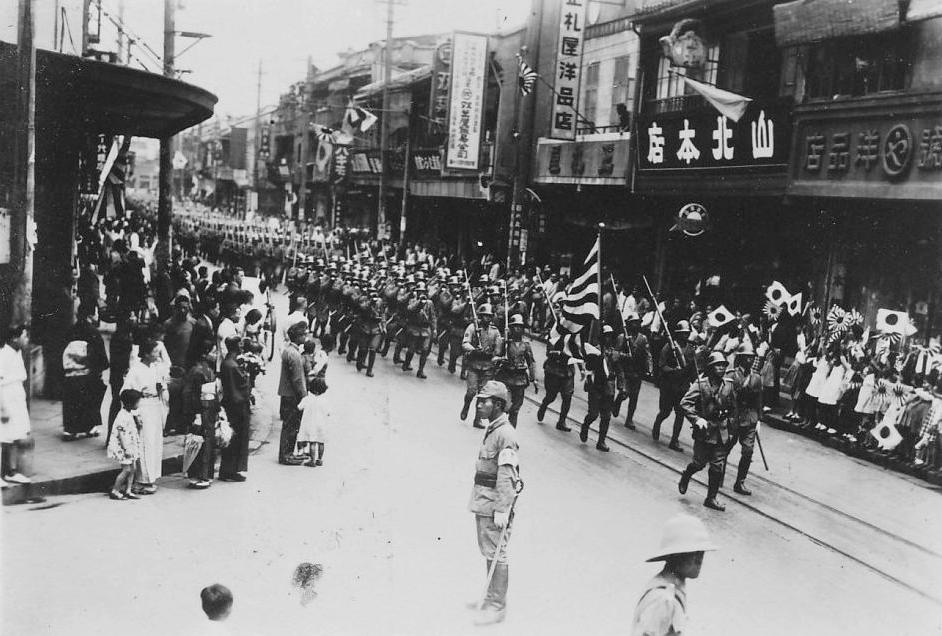
Battle for Shanghai (1937)

Figure 1.--This is an offical Japanese photograph of a naval landing group parading through Shanghai after the city was secured, we think in 1937. It shows a very orderly event, in fact when there Japanese Army marched into the city, seizing assets and carting away anything of value. They conducted wide-spread attacks on Chinese civilians when the army entered the city. The stubborn fighting in Shanghai was one reason the Japanese acted so brutally when they took Nanking. The Japanese respected the European enclaves.. A.
|
|
Nationalist soldiers resisted the Japanese at the Marco Polo Bridge. They were not acting on Chiang Kai-shek who favored a moderate approach to the Japanese. Chiang and the KMT did not have full control over field commanders. The IJA launched, however, a major response which would become a full invasion of China proper-the Second Sino-Japanese war. The Japanese seized Peking (July 29, 1937). Shanghai was China's principal port and its location close to the capital of Peking made it strategically the most important city in China. The war for Shanghai began about 10 years before the Japanese attack on Pearl Harbor. The importance of Shanghai meant that it would be the scene of major combat. Chiang who refused to commit the Nationalist Army to defend Manchuria, realized that he could not refuse to resist an invasion of China proper and maintain his position. He thus ordered the Nationalist forces to resist. Chang had been preparing for just such an attack. He had been training men under the disguise of police training. The Chinese were preparing defensive lines between Nanking and Shanghai with German military assistance. A junior Japanese officer, First Lieutenant Isao Oyama of the Japanese Naval Special Landing Forces, attempted to take control of Hungchiao Airport (August 9). This was a violation of the ceasefire after the 1932 battle. Chinese policemen resisted the Japanese and killed Oyama. The Japanese consul general in Shanghai apologized for Oyama's action, but demanded the Chinese police force, the Peace Preservation Corps, to disarm. Japanese troops were moving toward Shanghai as part of the already planned seizure of Shanghai and were using the Oyama incident as a pretext. Chiang also broke the ceasefire agreement by moving troops into Shanghai (August 11). He committed the 87th and 88th divisions, two of the best in his army, to seize and hold Shanghai. Both had been trained by German officers. The battle for Shanghai became the first battle of the War. The struggle for Shanghai, called the Battle of Songhu by the Chinese, would be the first of 22 battles in the Second Sino-Japanese War. The Japanese for diplomatic reasons did not want to refer to it as a war and instead referred to it as the China Incident. The small and poorly trained Chinese Air Force attempted to support the soldiers defending Shanghai. They attacked Japanese ships in the Shanghai harbor (August 13, 1937). They targeted the light cruiser Idzumo. As a crowd of civilians cheered, bombs missed the cruiser and fell on the Palace Hotel and in the street full of civilians. The carnage became known as "Bloody Saturday". They put up a major fight for the city which lasted 3 months. Whole districts of Shanghai were destroyed in the fighting. The Japanese mobilized over 200,000 troops supported by naval vessels and aircraft to seize Shanghai. . The Japanese bombed the city which had no air defenses. [Jing-hui, pp. 109-11] There are reports that the Japanese Army used chemical weapons in the battle for Shanghai. They eventually drove the Chinese out, but were shocked at the intensity of the Chinese fighting and the scale of their own losses. The Japanese victory was in part as a result of naval artillery fire and aerial bombing. Chiang eventually was forced to order a fighting withdrawal into the interior. The Japanese Army marched into the city, seizing assets and carting away anything of value. They conducted wide spread attacks on Chinese civilians when the army entered the city. The stubborn fighting in Shanghai was one reason the Japanese acted so brutally when they took Nanking. The Japanese respected the European enclaves.
CIH -- WW II

Navigate the CIH World War II Section:
[Return to Main World War II Shanghai page]
[Return to Main Japanese invasion of China page]
[Return to Main World War II Chinese-Japanese War page]
[Return to Main military style page]
[Biographies]
[Campaigns]
[Children]
[Countries]
[Deciding factors]
[Diplomacy]
[Geo-political crisis]
[Economics]
[Home front]
[Intelligence]
[POWs]
[Resistance]
[Race]
[Refugees]
[Technology]
[Bibliographies]
[Contributions]
[FAQs]
[Images]
[Links]
[Registration]
[Tools]
[Return to Main World War II page]
[Return to Main war essay page]
Created: 7:08 PM 10/29/2016
Last updated: 7:08 PM 10/29/2016



